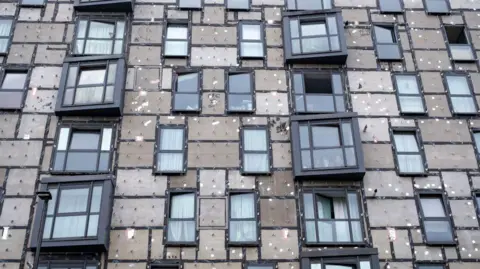[ad_1]
 Getty Images
Getty ImagesThe government could miss its own cladding removal completion date if progress is not made to speed up the process, the UK’s spending watchdog has said.
In a new report, the National Audit Office (NAO) said up to 60% of buildings with dangerous cladding had still not been identified by the government, and at its current rate of progress it was due to miss its own estimated completion date of 2035 for the works.
The report follows the conclusion of the Grenfell Inquiry in September, which found risks had been ignored and there was “systematic dishonesty” from those who made and sold the cladding involved in the fire in west London in 2017, in which 72 people died.
The government has been contacted for a response.
 PA Media
PA MediaThe report assessed how fast the Ministry of Housing, Communities and Local Government (MHCLG) was completing work to replace dangerous cladding from tower blocks in England, and aimed to provide an update to a previous NAO report in 2020.
It found there had been “a substantial increase in remediation activity” since then, with 4,771 buildings taller than 11 metres being brought under the government’s remedial works scheme as of August.
However, an estimated 7,200 more buildings in England with such cladding still had not been identified and some “may never”, the NAO continued.
Progress with replacing the cladding was also slow, it found.
Although the MHCLG spent £2.3bn carrying out work on identified buildings, the report said work had only been completed on roughly a third of them and was yet to start on half.
The government’s suggested end date for completing cladding works on these buildings was 2035 but it was not on course to meet this deadline and “there are significant challenges to overcome”, the report stated.
‘Financial and emotional stress’
The NAO recommended that if progress with identifying buildings with dangerous cladding did not improve by the end of 2024, the government should consider other measures.
These include mandatory registration for medium-rise buildings – and as with high-rise buildings under the Building Safety Act 2022, tougher enforcement activity and action to help with disputes between residents and building owners.
“Many people still do not know when their buildings will be made safe, contributing to residents suffering significant financial and emotional distress,” the report said.
The watchdog also highlighted there were issues with keeping taxpayers’ contributions to the works capped at £5.1bn.
The MHCLG’s estimate for costs for all the works amounted to £16.6bn and the NAO said although the government planned to recoup about £3.4bn from a new Building Safety Levy, this was not expected to be introduced until autumn 2025 at the earliest.
In London, more than £1bn has been paid out to take dangerous cladding off tower blocks in the past six years.
The Greater London Authority, which manages the schemes on behalf of government, said 58% were now either fully remediated, or work was under way.
 Getty Images
Getty ImagesThe report findings come after Chancellor Rachel Reeves announced in the Budget that the government would invest more than £1bn for repairs to buildings with dangerous cladding in 2025-26, which includes new investment to speed up remediation of social housing.
Gareth Davies, head of the NAO, said: “There is a long way to go before all affected buildings are made safe, and risks MHCLG must address if its approach is to succeed.
“To stick to its £5.1bn cap in the long run, MHCLG needs to ensure that it can recoup funds through successful implementation of the proposed Building Safety Levy.”
Sir Geoffrey Clifton-Brown, chair of the Commons’ Public Accounts Committee, who previously met survivors of the Grenfell fire, said “the programme is falling behind schedule and MHCLG needs to pick up the pace to get it back on track,” adding “the government must take steps to better protect the taxpayer”.
“It urgently needs to ensure its fraud controls are working and that developers contribute their fair share to the costs.”
[ad_2]
Source link




